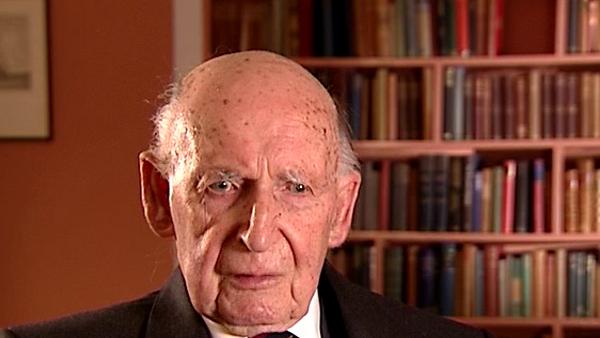NEXT STORY

The survival of Jodrell Bank
RELATED STORIES

NEXT STORY

The survival of Jodrell Bank
RELATED STORIES


|
Views | Duration | |
|---|---|---|---|
| 91. The MK II telescope | 61 | 02:47 | |
| 92. The Fleck Commitee: Permission to build a 400ft telescope | 53 | 05:12 | |
| 93. No funding for the 400ft telescope | 65 | 03:48 | |
| 94. The MERLIN system | 71 | 03:13 | |
| 95. The survival of Jodrell Bank | 84 | 01:42 | |
| 96. Trying to raise the money to pay off our debts | 68 | 04:04 | |
| 97. The Reith Lectures and USAF Project Able | 88 | 07:48 | |
| 98. The American rockets fail to get to the Moon | 114 | 01:40 | |
| 99. The Russians succeed in sending a rocket to the Moon | 111 | 07:33 | |
| 100. The fairytale end of our debt | 135 | 03:27 |


Well, we had a consolation prize, and that consolation prize was that we could build a system, first proposed by Henry Palmer, on the basis of interim metric work in the late '50s and early '60s, of what he called a four square interferometer. Well, this developed into what is now known as MERLIN, the multi element radio-linked interferometer, and in the few years before I retired in 1981, we had obtained sights in... in Knockin, and... and I was instrumental in getting that site from Lord Bradford, whom I knew. He... he owned a piece of land there, which he... which we agreed to build one of the telescopes, which it was then not... not economical to make, to make in England. It may interest you to know that I, of course, asked Husband if he could design us an 80ft telescope. He said, 'Certainly I can, but I warn you, it'd be much cheaper to buy one from... from the United States', such has the cost of work gone up in England.
And so I got in touch with the... with the Americans, and they agreed that we could buy an extra model of the telescopes they... they were using in their... in their network, and so that is how the first E-systems telescope was built at... at Knockin. And there's another one at it was then near Jodrell, Tabley. I also got permission to use the telescope which Hey had built on the old runway, which we had used during the war at Defford Airport and, in fact, that telescope is an 80ft dish, is still in use in this MERLIN network, and shortly after I retired, Graham Smith, who succeeded me, in the 1980s, he arranged for another telescope of this network to be built on a site near Cambridge, or in fact on the... the original radio astronomy site in Cambridge, so that MERLIN system is... is now a very powerful network and is extremely important and, of course, I... I must agree that the results obtained, even with the preliminary MERLIN Network, before my retirement and subsequently, has been extremely important. And now, what is commonly known as E-MERLIN, is being prepared using optical-fibre connectors instead of landlines to connect the telescopes and this will be very powerful instrument for the future.
Bernard Lovell (1913-2012), British radio astronomer and founder of the Jodrell Bank Observatory, received an OBE in 1946 for his work on radar, and was knighted in 1961 for his contribution to the development of radio astronomy. He obtained a PhD in 1936 at the University of Bristol. His steerable radio telescope, which tracked Sputnik across the sky, is now named the Lovell telescope.
Title: The MERLIN system
Listeners: Megan Argo Alastair Gunn
Megan Argo is an astronomer at the University of Manchester's Jodrell Bank Observatory researching supernovae and star formation in nearby starburst galaxies. As well as research, she is involved with events in the Observatory's Visitor Centre explaining both astronomy and the history of the Observatory to the public.
Alastair Gunn is an astrophysicist at Jodrell Bank Observatory, University of Manchester. He is responsible for the coordination and execution of international radio astronomical observations at the institute and his professional research concerns the extended atmospheres of highly active binary stars. Alastair has a deep interest and knowledge of the history of radio astronomy in general and of Jodrell Bank in particular. He has written extensively about Jodrell Bank's history.
Tags: England, USA, Jodrell Bank, Cambridge, H P Palmer, Charles Husband
Duration: 3 minutes, 13 seconds
Date story recorded: January 2007
Date story went live: 05 September 2008